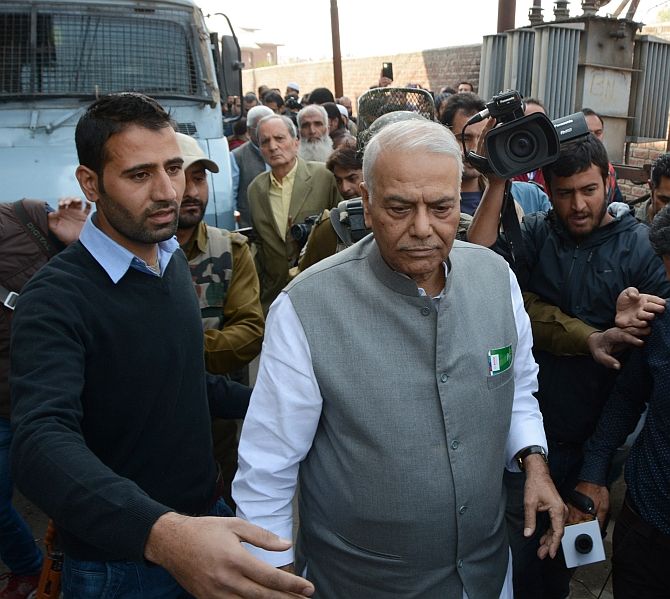
'The first clear cut call for 'engagement with all stake holders including separatists' came, not from the political class but the men in uniform,' points out Mohammad Sayeed Malik, the distinguished observer on Kashmir.
The explosion of suppressed expectations in the choked Kashmir Valley, triggered by the visit of a five-member non-official, fact-finding team, headed by former Union minister Yashwant Sinha, provides a measure of below-the-surface frustration in the state.
This has been caused, on the one hand, by the recklessness of the local separatist leadership spearheading the four-month long violent uprising and, on the other, by the equally arrogant and unresponsive central government.
This scenario contrasts with the defiant sullenness which defined the earlier two visits of Union Home Minister Rajnath Singh and by an all-party parliamentary delegation when the main propellers of the unrest avoided even eye contact with the visitors and literally shut their doors,
The ease and eagerness with which the Sinha team was courted by one and all, from Syed Ali Shah Geelani to representatives from business and civil society, strengthened the impression that the earlier reservation was only posturing, for tactical reasons or under pressure from some invisible forces, or a bit of both.
Even so, this belated realisation that engagement was inevitable as well as desirable is a welcome development, considering the huge losses resulting from total disengagement.
Nearly 100 people have lost their lives since the July 8 killing of the Hizbul Mujahideen's Burhan Wani in an encounter in south Kashmir. Normal life across the Kashmir Valley remains totally paralysed since then.
Adding to multiple ironies of the Kashmir problem is the one that Sinha's team of five individuals is known to have no brief from anyone in authority in New Delhi.
And yet it happened to be breaking the ice while the relatively empowered parliamentary delegation had to return virtually empty handed, after completing the formality of convincing the convinced -- mainstream politicians and their related non-political attachments.
Ditto for the Union home minister.
The central government and the Bharatiya Janata Party needlessly went as far as to disassociate themselves from the Sinha-led team and its visit to Kashmir.
It made no difference where it mattered -- on the ground. The separatists responded as if the visitors were god-send. Unlike only a month or so back, nothing would convince them to at least meet, if not talk with visitors from New Delhi.
Indicators on the ground in the Kashmir Valley suggest a perceptible, though as yet not so distinctly, that fatigue is beginning to set it and take its toll.
It is an open secret across the Valley, that the apparent face of the uprising, the two factions of the Hurriyat Conference led by Geelani and Mirwaiz Ummar Farooq and Yasin Malik, were actually not in command, or at least certainly not in full command.
Effective leadership on the ground remains confusingly dispersed with teenagers acting as 'commanders' in their respective local areas.
The Hurriyat leadership's track record in the three decade long resistance movement clearly does not square up with the dynamics of its current phase.
This one has been the toughest and harshly punishing for ordinary people.
Life in the Valley has never before been shut for so long and with schools targeted for arson.
Its backlash is beginning to spill over into the open with the hardest hit having reached the end of the tether.
Lest the Sinha-team is tempted to nurse notion of its efficacy (vis a vis the earlier could-be interlocutors) and overestimate its ability and capability, it would do better by confining itself to sharing its experience and impressions with the authorities in New Delhi, that is presuming that by now there is some appetite for such interaction that was not the case so far.
Visiting non-official teams and individuals can undoubtedly contribute to reinforce the process of engagement, but if those who eventually matter and ought to take the call are not interested, for whatever reason, all these initiatives are destined to backfire.
That would certainly mean aggravation of both, alienation and frustration.
It was not for nothing that the first clear cut call for 'engagement with all stake holders including separatists' came, not from the political class but the men in uniform.
Lieutenant General D S Hooda, the Northern Army GOC-in-C, made a public appearance at the beginning of the uprising to convey the message.
Again, it is the army's intervention at the ground level, especially in the most seriously affected villages and towns, that has put a check on the dangerous drift towards lawlessness and violence.
Restoration of civil authority is going to be a long drawn affair, depending upon how fast the local administration is able to reassemble its disintegrated body parts.
All said and done, the team led by Yashwant Sinha had reason to be satisfied with what it was able to achieve in Kashmir. To that extent, it is a job well done.
However, it is useful to remember it is not happening for the first time.
As they say the path to hell is paved with all good intentions. And Kashmir is notoriously known as the graveyard of reputations.
Only time can tell if there are any takers within the ruling establishment in New Delhi to carry the good work forward. In the given parameters, that might be hoping against hope.
But then Kashmir is already rendered a hopeless case, from several angles -- local, national and international
For the Hurriyat and other props of the uprising the writing is on the wall: The 'Revolution' is just beginning to eat its own children.
Their eagerness to meet the Sinha team after having haughtily spurned parliamentarians and others suggests that the message is beginning to sink in.
As it happens so often in Kashmir, everybody who is anybody likes to join the chorus of the day.
Today the flavour is engagement and dialogue. Till now it was 'now or never.'










